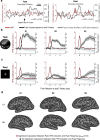Pupillary Dynamics Link Spontaneous and Task-Evoked Activations Recorded Directly from Human Insula
- PMID: 32631937
- PMCID: PMC7406275
- DOI: 10.1523/JNEUROSCI.0435-20.2020
Pupillary Dynamics Link Spontaneous and Task-Evoked Activations Recorded Directly from Human Insula
Abstract
Spontaneous activations within neuronal populations can emerge similarly to "task-evoked" activations elicited during cognitive performance or sensory stimulation. We hypothesized that spontaneous activations within a given brain region have comparable functional and physiological properties to task-evoked activations. Using human intracranial EEG with concurrent pupillometry in 3 subjects (2 males, 1 female), we localized neuronal populations in the dorsal anterior insular cortex that showed task-evoked activations correlating positively with the magnitude of pupil dilation during a continuous performance task. The pupillary response peaks lagged behind insular activations by several hundreds of milliseconds. We then detected spontaneous activations, within the same neuronal populations of insular cortex, that emerged intermittently during a wakeful "resting state" and that had comparable electrophysiological properties (magnitude, duration, and spectral signature) to task-evoked activations. Critically, similar to task-evoked activations, spontaneous activations systematically preceded phasic pupil dilations with a strikingly similar temporal profile. Our findings suggest similar neurophysiological profiles between spontaneous and task-evoked activations in the human insula and support a clear link between these activations and autonomic functions measured by dynamics of pupillary dilation.SIGNIFICANCE STATEMENT Most of our knowledge about activations in the human brain is derived from studies of responses to external events and experimental conditions (i.e., "task-evoked" activations). We obtained direct neural recordings from electrodes implanted in human subjects and showed that activations emerge spontaneously and have strong similarities to task-evoked activations(e.g., magnitude, temporal profile) within the same populations of neurons. Within the dorsal anterior insula, a brain region implicated in salience processing and alertness, activations that are either spontaneous or task-evoked are coupled with brief dilations of the pupil. Our findings underscore how spontaneous brain activity, a major current focus of human neuroimaging studies aimed at developing biomarkers of disease, is relevant to ongoing physiological and possibly self-generated mental processes.
Keywords: arousal; attention; intracranial EEG; pupillometry; resting state; sympathetic.
Copyright © 2020 the authors.
Figures






Comment in
-
Disentangling the Association between the Insula and the Autonomic Nervous System.J Neurosci. 2021 Apr 7;41(14):3051-3053. doi: 10.1523/JNEUROSCI.2225-20.2021. J Neurosci. 2021. PMID: 33827971 Free PMC article. No abstract available.
Similar articles
-
Your eyes give you away: prestimulus changes in pupil diameter correlate with poststimulus task-related EEG dynamics.PLoS One. 2014 Mar 11;9(3):e91321. doi: 10.1371/journal.pone.0091321. eCollection 2014. PLoS One. 2014. PMID: 24618591 Free PMC article.
-
Neural correlates of pupil dilation during human fear learning.Neuroimage. 2017 Feb 15;147:186-197. doi: 10.1016/j.neuroimage.2016.11.072. Epub 2016 Dec 1. Neuroimage. 2017. PMID: 27915119
-
Role of the insula in top-down processing: an intracranial EEG study using a visual oddball detection paradigm.Brain Struct Funct. 2019 Jul;224(6):2045-2059. doi: 10.1007/s00429-019-01892-y. Epub 2019 May 25. Brain Struct Funct. 2019. PMID: 31129871
-
Eye pupil - a window into central autonomic regulation via emotional/cognitive processing.Physiol Res. 2021 Dec 30;70(Suppl4):S669-S682. doi: 10.33549/physiolres.934749. Physiol Res. 2021. PMID: 35199551 Free PMC article. Review.
-
Back to Pupillometry: How Cortical Network State Fluctuations Tracked by Pupil Dynamics Could Explain Neural Signal Variability in Human Cognitive Neuroscience.eNeuro. 2017 Dec 26;4(6):ENEURO.0293-16.2017. doi: 10.1523/ENEURO.0293-16.2017. eCollection 2017 Nov-Dec. eNeuro. 2017. PMID: 29379876 Free PMC article. Review.
Cited by
-
Pupil diameter is not an accurate real-time readout of locus coeruleus activity.Elife. 2022 Feb 2;11:e70510. doi: 10.7554/eLife.70510. Elife. 2022. PMID: 35107419 Free PMC article.
-
An insula hierarchical network architecture for active interoceptive inference.R Soc Open Sci. 2022 Jun 29;9(6):220226. doi: 10.1098/rsos.220226. eCollection 2022 Jun. R Soc Open Sci. 2022. PMID: 35774133 Free PMC article. Review.
-
Functional network antagonism and consciousness.Netw Neurosci. 2022 Oct 1;6(4):998-1009. doi: 10.1162/netn_a_00244. eCollection 2022. Netw Neurosci. 2022. PMID: 38800457 Free PMC article.
-
Dynamic interactions between anterior insula and anterior cingulate cortex link perceptual features and heart rate variability during movie viewing.Netw Neurosci. 2023 Jun 30;7(2):557-577. doi: 10.1162/netn_a_00295. eCollection 2023. Netw Neurosci. 2023. PMID: 37397892 Free PMC article.
-
Why is everyone talking about brain state?Trends Neurosci. 2023 Jul;46(7):508-524. doi: 10.1016/j.tins.2023.04.001. Epub 2023 May 8. Trends Neurosci. 2023. PMID: 37164869 Free PMC article. Review.
References
-
- Bastin J, Deman P, David O, Gueguen M, Benis D, Minotti L, Hoffman D, Combrisson E, Kujala J, Perrone-Bertolotti M, Kahane P, Lachaux JP, Jerbi K (2017) Direct recordings from human anterior insula reveal its leading role within the error-monitoring network. Cereb Cortex 27:1545–1557. 10.1093/cercor/bhv352 - DOI - PubMed
Publication types
MeSH terms
Grants and funding
LinkOut - more resources
Full Text Sources
